wheel bolts CADILLAC CATERA 1997 1.G Owners Manual
[x] Cancel search | Manufacturer: CADILLAC, Model Year: 1997, Model line: CATERA, Model: CADILLAC CATERA 1997 1.GPages: 338, PDF Size: 18.02 MB
Page 205 of 338

Downloaded from www.Manualslib.com manuals search engine Parking on Hills
You really should not park your vehicle, with a trailer
attached,
on a hill. If something goes wrong, your rig
could start to move. People can be injured, and both
your vehicle and the trailer can be damaged.
But if
you ever have to park your rig on a hill, here’s
how to do it:
1. Apply the regular brakes, but do not shift into
PARK
(P).
2. Have someone place chocks under the trailer wheels.
3. When the wheel chocks are in place, release the
regular brakes until the chocks absorb the load.
4. Reapply the regular brakes. Then shift into
5. Release the regular brakes. PARK (P) firmly and apply the parking brake.
When You Are Ready to Leave After
Parking on a Hill
1. Apply your regular brakes and hold the pedal down
while you:
Start your engine;
Shift into a gear; and
2. Let up on the brake pedal.
3. Drive slowly until the trailer is clear of the chocks.
4. Stop and have someone pick up and store the chocks.
Maintenance When Trailer Towing
Your vehicle will need service more often when you’re
pulling a trailer. See the Maintenance Schedule for more
on this. Things that are especially important
in trailer
operation are automatic transmission fluid (don’t
overfill), engine oil, axle lubricant, belt, cooling system
and brake adjustment. Each
of these is covered in this
manual, and the Index will help you find them quickly.
If you’re trailering, it’s a good idea to review these
sections before
you start your trip.
Check periodically to see that all hitch nuts and bolts
are tight.
4-38
Page 234 of 338
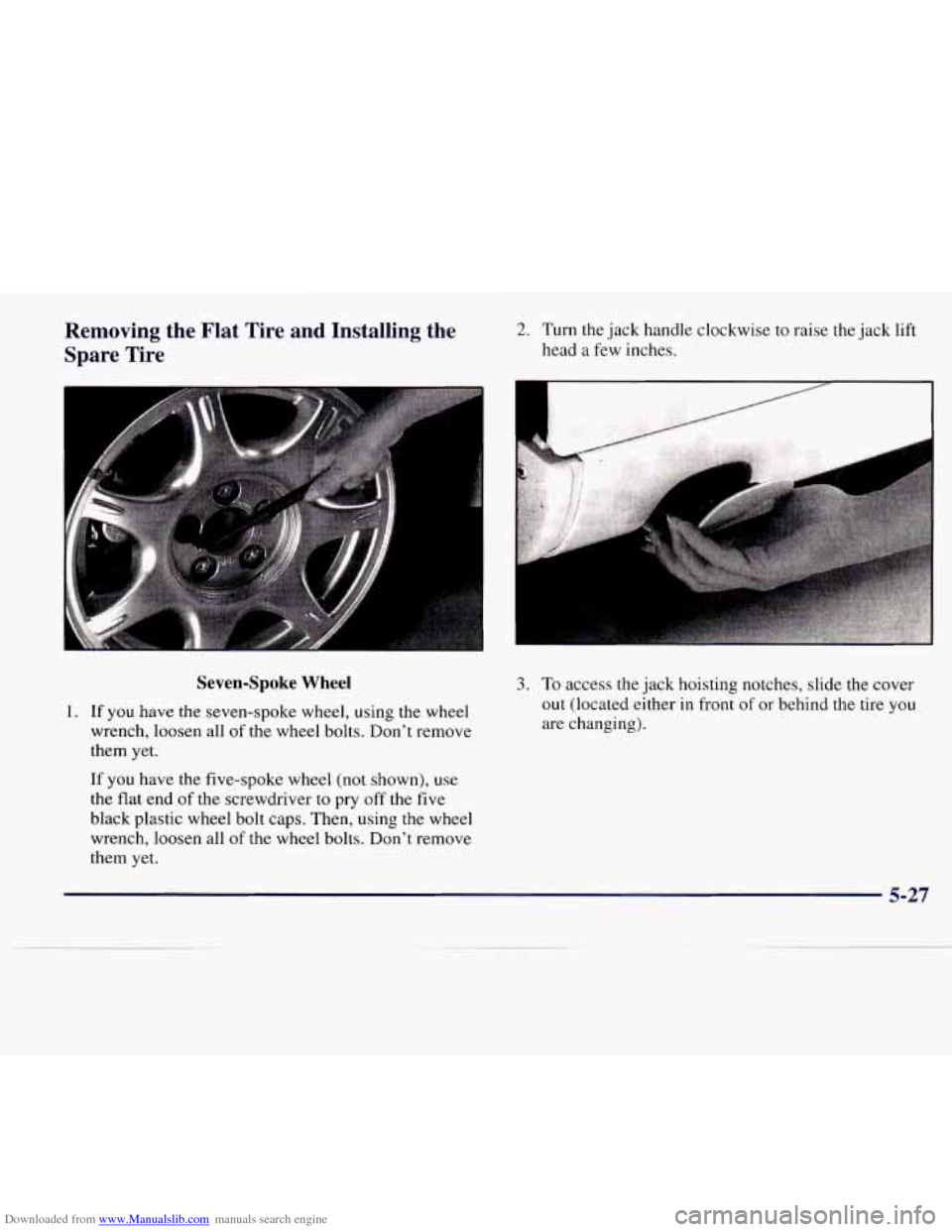
Downloaded from www.Manualslib.com manuals search engine Removing the Flat Tire and Installing the
Spare Tire
Seven-Spoke Wheel
1. If you have the seven-spoke wheel, using the wheel
wrench, loosen all of the wheel bolts. Don’t remove
them yet.
If
you have the five-spoke wheel (not shown), use
the flat end of the screwdriver to pry off the five
black plastic wheel bolt caps.
Then, using the wheel
wrench, loosen all
of the wheel bolts. Don’t remove
them
yet.
2. Turn the jack handle clockwise to raise the jack lift
head
a few inches.
3. To access the jack hoisting notches, slide the cover
out (located either in front of
or behind the tire you
are changing).
5-27
Page 236 of 338
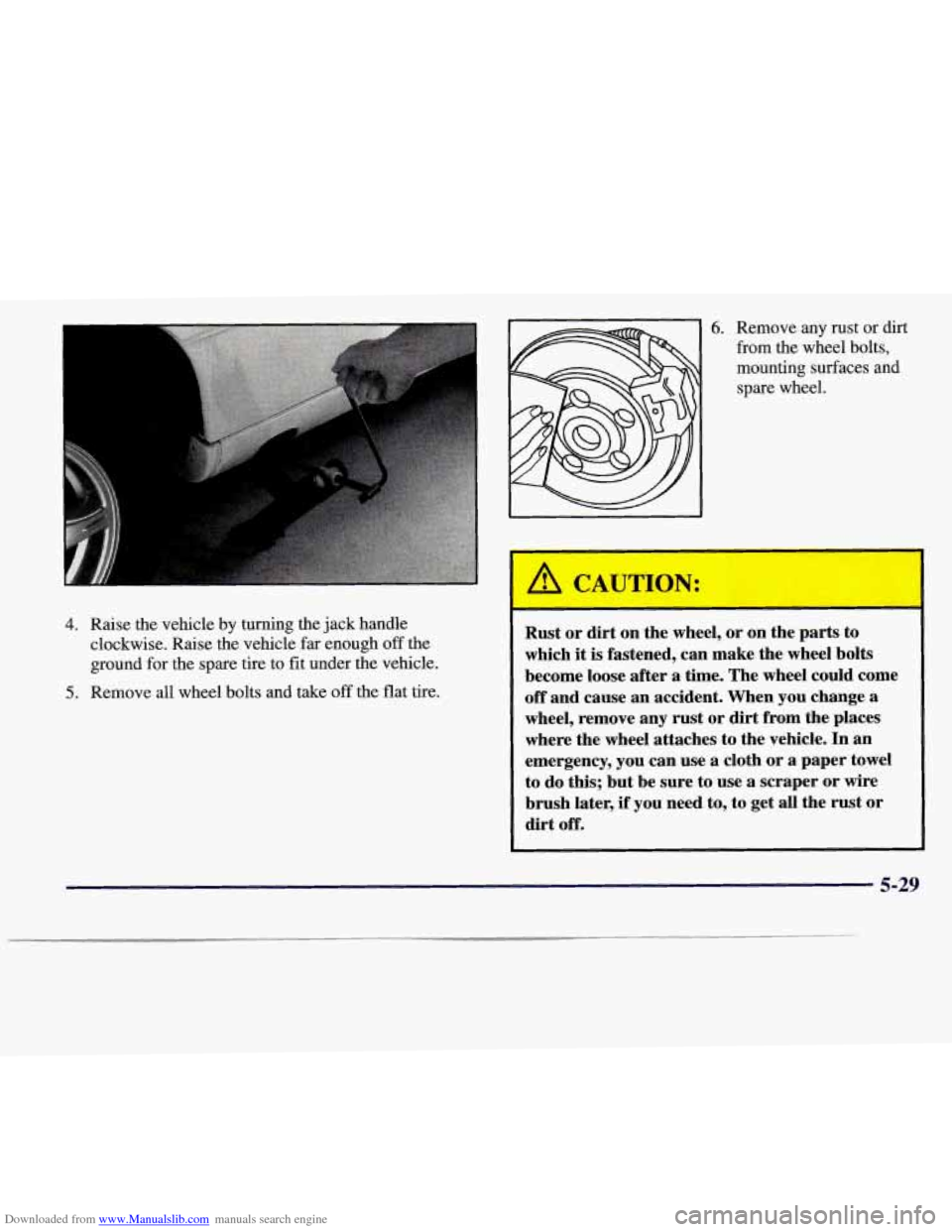
Downloaded from www.Manualslib.com manuals search engine 4. Raise the vehicle by turning the jack handle
clockwise. Raise the vehicle far enough
off the
ground for the spare tire to fit under the vehicle.
5. Remove all wheel bolts and take off the flat tire.
6. Remove any rust or dirt
from the wheel bolts,
mounting surfaces and
spare wheel.
A CAUTION:
I
Rust or dirt on the wheel, or on the parts to
which it is fastened, can make the wheel
bolts
become loose after a time. The wheel could come
off and cause an accident. When you change a
wheel, remove any rust or dirt from the places
where the wheel attaches to the vehicle. In an
emergency, you can use a cloth
or a paper towel
to do this; but be sure to use a scraper or wire
brush later, if you need to, to get all the rust
or
dirt off.
5-29
Page 237 of 338
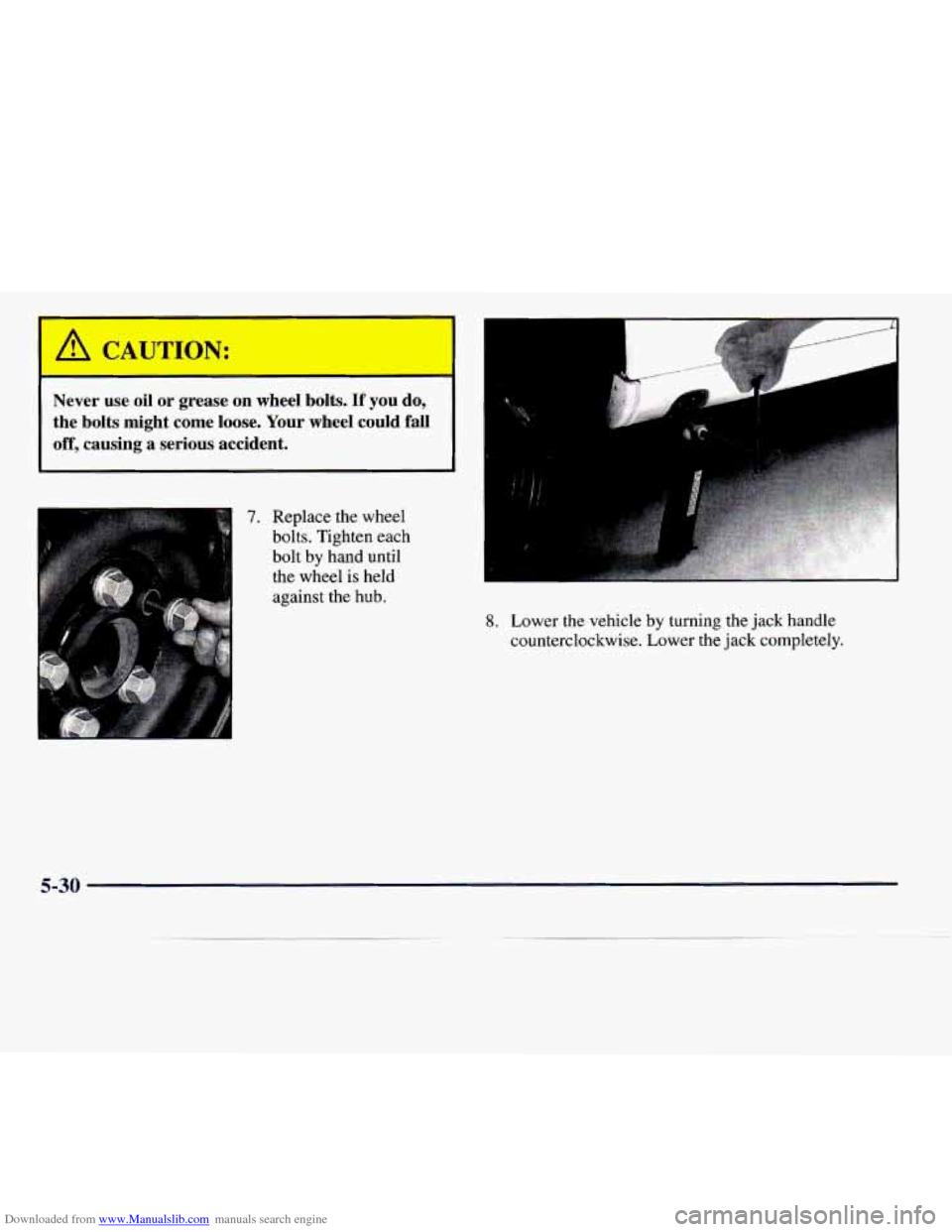
Downloaded from www.Manualslib.com manuals search engine A CAUTION:
r
Never use oil or grease on wheel bolts. If you do,
the bolts might come loose. Your wheel could fall
off, causing a serious accident.
7. Replace the wheel
bolts. Tighten each
bolt by hand until
the wheel
is held
against the hub.
8. Lower the vehicle by turning the jack handle
counterclockwise. Lower the jack completely.
5-30
Page 238 of 338

Downloaded from www.Manualslib.com manuals search engine 9. Tighten the wheel
bolts firmly
in a
criss-cross sequence
as shown.
1 A CAUTION:
I
Incorrect wheel bolts or improperly tightened
wheel bolts can cause the wheel to become loose
and even come
off. This could lead to an accident.
Be sure to use
the correct wheel bolts. If you have
to replace them, be sure to get new
GM original
equipment wheel bolts.
Stop somewhere
as soon as you can and have the
bolts tightened with
a torque wrench to 80 lb-ft
(110 Nam).
NOTICE:
Improperly tightened wheel bolts can lead to
brake pulsation and rotor damage. To avoid
expensive brake repairs, evenly tighten the wheel
bolts in the proper sequence and to the proper
torque specification.
5-31
Page 271 of 338

Downloaded from www.Manualslib.com manuals search engine Some driving conditions or climates may cause a
brake squeal when the brakes are first applied or
lightly applied. This does not mean something is
wrong with your brakes.
Properly torqued wheel bolts are necessary to help
prevent brake pulsation. When tires are rotated,
inspect brake pads for wear and evenly torque wheel
bolts in the proper sequence
to GM specifications.
Brake linings should always be replaced as complete
axle sets.
See “Brake System Inspection’’ in Section
7 of the
Maintenance Schedule booklet under Part
C “Periodic
Maintenance Inspections.”
Brake Pedal Travel
See your dealer if the brake pedal does not return to
normal height, or if there is a rapid increase in pedal
travel. This could be a sign
of brake trouble.
Brake Adjustment
Every time you apply the brakes, with or without the
vehicle moving, your brakes adjust for wear.
Replacing Brake System Parts
The braking system on a modem vehicle is complex.
Its many parts have to be
of top quality and work well
together
if the vehicle is to have really good braking.
Your vehicle was designed and tested with top-quality
GM brake parts. When you replace parts of your braking
system
-- for example, when your brake linings wear
down and you have to have new ones put in
-- be sure
you get new approved GM replacement parts. If you
don’t, your brakes may no longer work properly. For
example,
if someone puts in brake linings that are wrong
for your vehicle, the balance between your front and
rear brakes can change
-- for the worse. The braking
performance you’ve come
to expect can change in many
other ways
if someone puts in the wrong replacement
brake parts.
6-28
Page 283 of 338
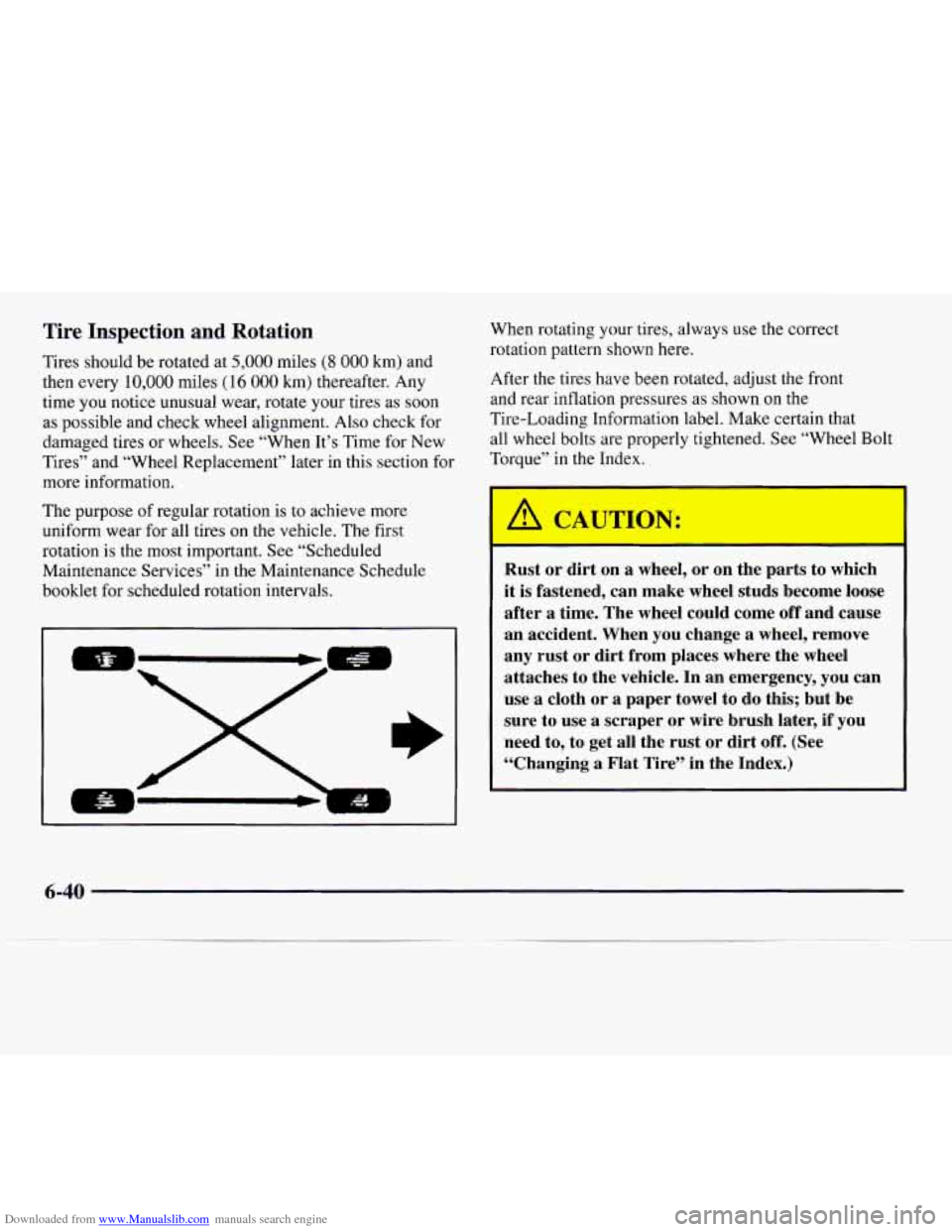
Downloaded from www.Manualslib.com manuals search engine Tire Inspection and Rotation
Tires should be rotated at 5,000 miles (8 000 km) and
then every
10,000 miles ( 16 000 km) thereafter. Any
time you notice unusual wear, rotate your tires as soon
as possible and check wheel alignment.
Also check for
damaged tires or wheels.
See “When It’s Time for New
Tires” and “Wheel Replacement” later in this section for
more information.
The purpose of regular rotation is to achieve more
uniform
wear for all tires on the vehicle. The first
rotation is the most important. See “Scheduled
Maintenance Services’’ in the Maintenance Schedule
booklet for scheduled rotation intervals. When rotating your tires,
always use the correct
rotation pattern shown here.
After the tires have been rotated, adjust the front
and rear inflation pressures as shown on the
Tire-Loading Information label. Make certain that all wheel bolts are properly tightened. See “Wheel Bolt
Torque”
in the Index.
Rust or dirt on a wheel, or on the parts to which
it is fastened, can make wheel studs become loose
after a time. The wheel could come off and cause
an accident. When you change
a wheel, remove
any rust or dirt from places where the wheel
attaches to the vehicle. In an emergency, you can
use a cloth or a paper towel to do this; but be
sure to use a scraper or wire brush later, if you
need to, to get all the rust or dirt off. (See
’ “Changing a Flat Tire” in the Index.)
6-40
Page 286 of 338
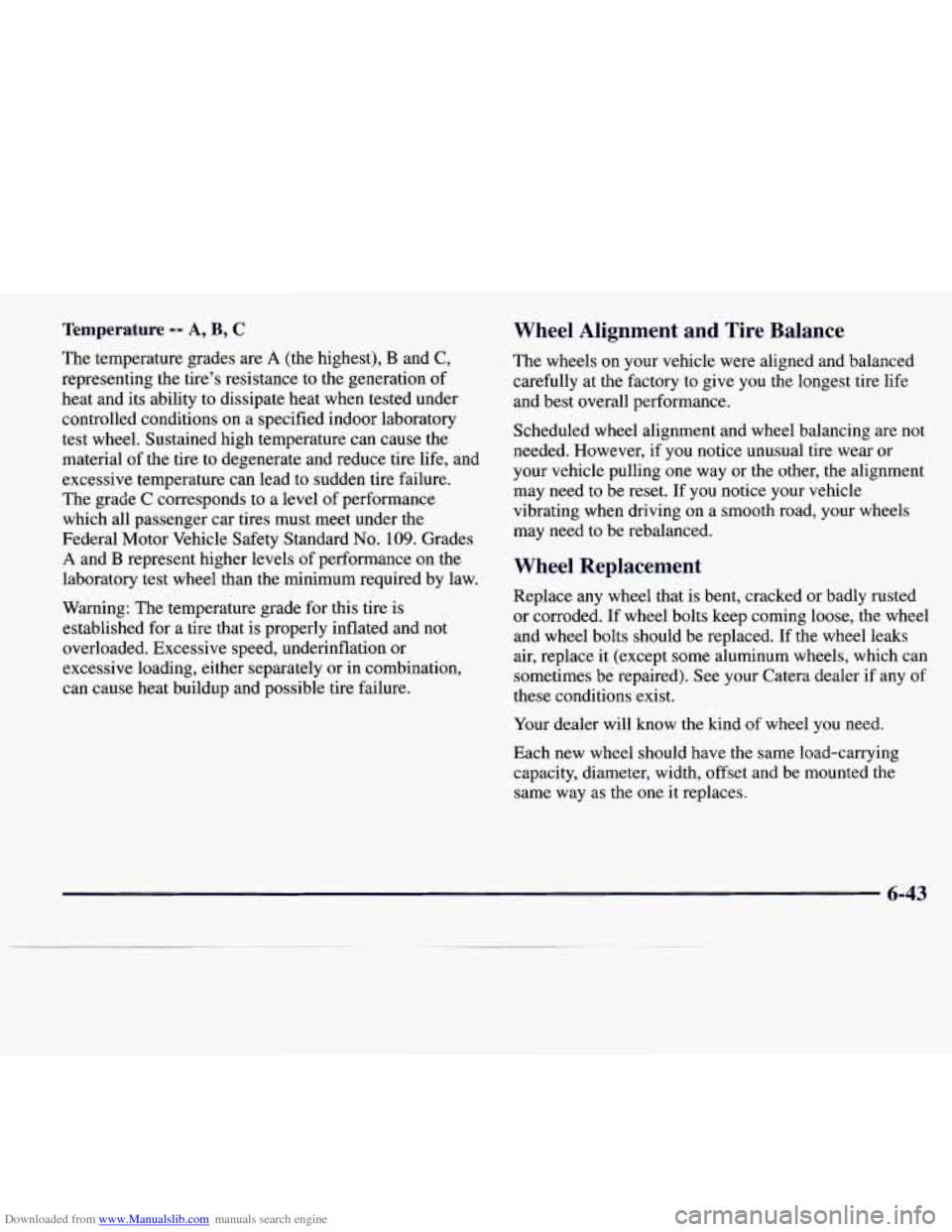
Downloaded from www.Manualslib.com manuals search engine Temperature -- A, B, C
The temperature grades are A (the highest), B and C,
representing the tire’s resistance to the generation of
heat and its ability to dissipate heat when tested under
controlled conditions on a specified indoor laboratory
test wheel. Sustained high temperature can cause the
material of the tire to degenerate and reduce tire life, and
excessive temperature can lead to sudden tire failure.
The grade
C corresponds to a level of performance
which all passenger car tires must meet under the
Federal Motor Vehicle Safety Standard
No. 109. Grades
A and B represent higher levels of performance on the
laboratory test wheel than the minimum required by law.
Warning: The temperature grade for this tire is
established for
a tire that is properly inflated and not
overloaded. Excessive speed, underinflation or
excessive loading, either separately or
in combination,
can cause heat buildup and possible tire failure.
Wheel Alignment and Tire Balance
The wheels on your vehicle were aligned and balanced
carefully at the factory to give you the longest tire life
and best overall performance.
Scheduled wheel alignment and wheel balancing are not
needed. However, if you notice unusual tire wear
or
your vehicle pulling one way or the other, the alignment
may need to be reset. If you notice your vehicle
vibrating when driving on a smooth road, your wheels
may need to be rebalanced.
Wheel Replacement
Replace any wheel that is bent, cracked or badly rusted
or corroded. If wheel bolts keep coming loose, the wheel
and wheel bolts should be replaced. If the wheel leaks
air, replace
it (except some aluminum wheels, which can
sometimes be repaired). See your Catera dealer if any of
these conditions exist.
Your dealer will know the kind
of wheel you need.
Each new wheel should have the same load-carrying
capacity, diameter, width, offset and be mounted the
same way
as the one it replaces.
6-43
Page 287 of 338
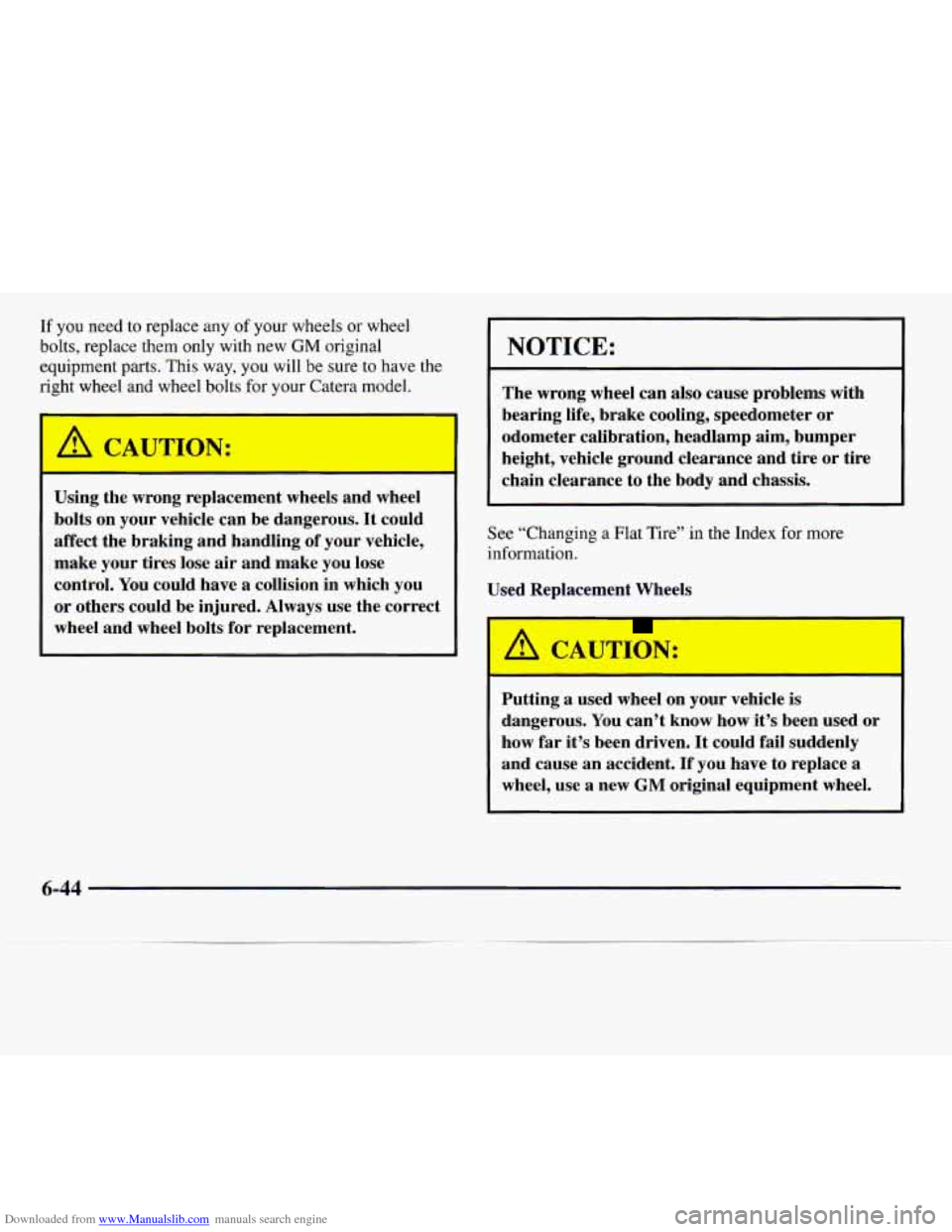
Downloaded from www.Manualslib.com manuals search engine If you need to replace any of your wheels or wheel
bolts, replace them only with new
GM original
equipment parts. This way,
you will be sure to have the
right wheel and wheel bolts for your Catera model.
Using the wrong replacement wheels and wheel
bolts on your vehicle can be dangerous. It could
affect the braking and handling
of your vehicle,
make your tires lose air and make you lose
control. You could have a collision in which you
or others could be injured. Always use the correct
wheel and wheel bolts for replacement.
I NOTICE:
The wrong wheel can also cause problems with
bearing life, brake cooling, speedometer or
odometer calibration, headlamp aim, bumper
height, vehicle ground clearance and tire or tire
chain clearance to the body and chassis.
See “Changing a Flat Tire” in the Index for more
information.
Used Replacement Wheels
I
Putting a used wheel on your vehicle is
dangerous. You can’t know how
it’s been used or
how far it’s been driven. It could fail suddenly
and cause an accident.
If you have to replace a
wheel, use a new GM original equipment wheel.
6-44